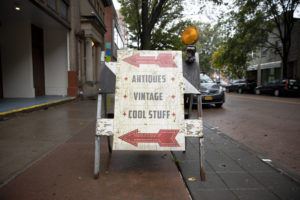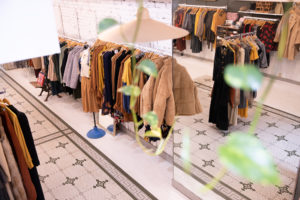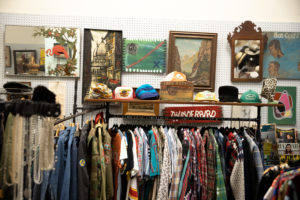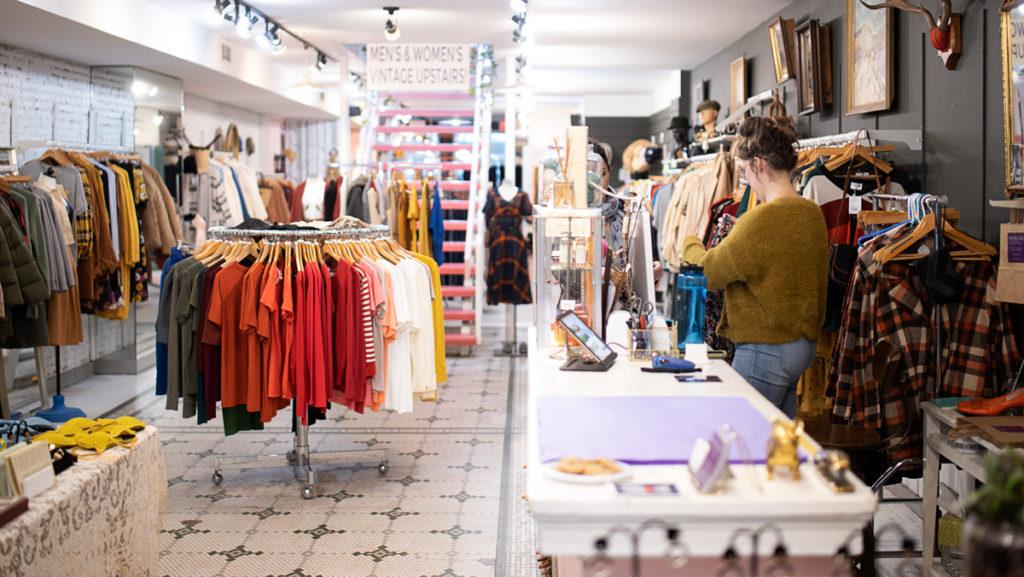Petrune and The Vintage Industry, both vintage stores on The Commons, are full of undiscovered treasures from different times. The scent of 100-year-old pages covers every inch of the shops, and the shelves are filled end-to-end with some of the strangest and most intriguing items on the market. Objects on sale are so old, it is hard to believe they are still in circulation — a blouse from the 1930s, a fedora from the 1920s and much more.
Petrune, located in the heart of The Commons, offers an array of products. At first glance, it seems to be a standard, small retail store offering typical items like sunglasses, bags and novelty socks, but up the pink and white staircase leading to the second floor is a cornucopia of vintage clothing selections for both men and women, along with an art gallery.

Petrune owner Domenica Brockton and her husband have history dealing with antique merchandise and because of this knowledge, she said, she said it was natural for her to want to build her career out of it. Before the couple opened Petrune approximately 14 years ago, Brockton owned a vintage furniture store in Brooklyn, New York, while her husband worked with antique textiles.
Brockton said she particularly enjoys working with vintage clothing because of how personal and emotionally intimate those items are to an individual.
“The way a garment looks says so much about the person that owned it,” she said. “It’s literally taking the shape of their body. It’s about as personal as you can get.”
Marie Sirakos has owned The Vintage Industry, located on W. State St., for almost 10 years, and the store offers strictly vintage items. It has more of the old attic feel and smells that is often associated with vintage stores. The store, while physically smaller than Petrune, is packed to the brim with a massive and varying selection of vintage items. Behind the store’s exterior, aged furniture is placed among wooden shelves, adorned with vases, globes and other knickknacks. The walls are covered in paintings and wall art. The room is a menagerie of intriguing objects.
Sirakos said her passion for vintage stems from childhood experiences with her mother, who sparked her interest in vintage collecting from a young age.
“I was eight or nine,” she said. “She would go to estate sales and garage sales and we would find things, and then we’d set up at an antique show and sell the things. I have a very strong passion for all these things in various categories. There’s a lot of fashion, artwork, just decoratives and things like that.”
In terms of merchandise, vintage shops vary widely because of the selective nature of vintage collectors. Brockman said shop owners carefully collect and curate items for their individual stores, making the selection at every establishment truly individual.

Vintage shops are often confused with thrift stores because they both sell items that come from and are donated by other people. However, there are many aspects of vintage stores that set them apart from the typical thrift store.
One key difference between thrift stores and vintage stores, Sirakos said, is how stores obtain the items they sell. While thrift stores take close to anything they are given and are designed to offer an affordable shopping experience, owners, and sometimes employees, of vintage stores go through a much more in-depth selection process.
“I search lots of places, basically anywhere things are for sale,” Sirakos said. “I choose items that I feel are in good condition, that are vintage and can be worn in a contemporary context that I feel I have clientele for, so it’s pretty subjective.”
Sirakos said that every week she goes to auctions, estate sales, thrift shops, garage sales and other antique stores. People also bring her clothes and she decides whether or not to buy them.
The same goes for Petrune. On its website, there is a section describing their process of acquiring clothes.
“Every week, we acquire new pieces from estate sales, auctions, and in-store customers who have family heirlooms that they hope will find a special home,” the website states.
“A thrift store will take anything,” Brockman said. “A lot of times it’s just donated. We work really hard to choose what’s in the store. We have kind of high standards about what we put in, and we try not to buy anything that you could’ve bought in Ithaca in the last 20 years. That’s kind of the benchmark.”
Companies and stores will often target a certain age demographic, but, Brockman said, people from all different generations stop by her store.
“People start shopping here at around 13–14 years old, as soon as they get into their grown-up size,” she said. “It goes right up to people of all ages, but I would say the strongest demographic is probably college-aged kids.”

Sophomore Brianna Lowe said that she’s been seeking out old clothes from both vintage and thrift stores for six years and that she finds every new store to be as exciting as the last.
“I always search for vintage stores, thrift stores, and there’s a bunch in The Commons, so I’m always like ‘Hey, can we go here?’” she said. “Just finding the old stuff and the smell of the old items, it’s so nice.”
Lowe said the possibility of finding an amazing new piece keeps the intrigue alive even if she does not find anything to buy during every shopping trip. Brockman said the aspect of never knowing what you might come across is what keeps people interested in vintage clothing.
“You want to go somewhere and see shops that you haven’t seen and items that you haven’t seen before,” she said. “That’s what you can find in a vintage shop.”














